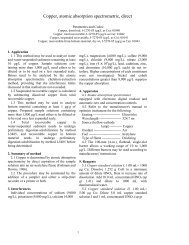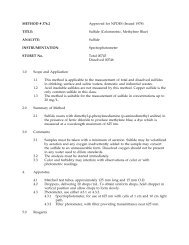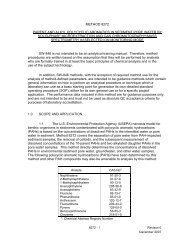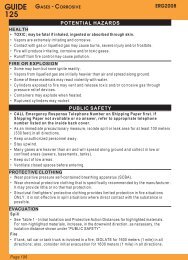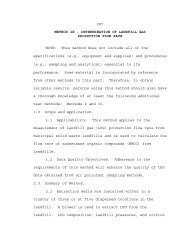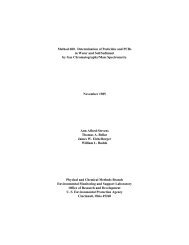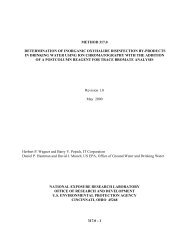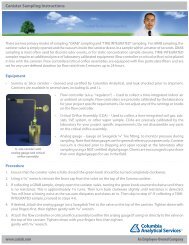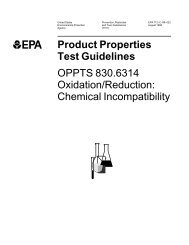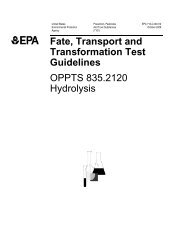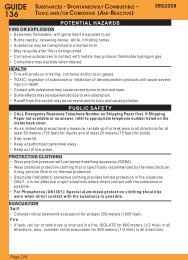View Actual EPA Method 8081A (PDF File)
View Actual EPA Method 8081A (PDF File)
View Actual EPA Method 8081A (PDF File)
You also want an ePaper? Increase the reach of your titles
YUMPU automatically turns print PDFs into web optimized ePapers that Google loves.
8.0 QUALITY CONTROL8.1 Refer to Chapter One and <strong>Method</strong> 8000 for specific quality control (QC) procedures.Quality control procedures to ensure the proper operation of the various sample preparationtechniques can be found in <strong>Method</strong> 3500. If an extract cleanup procedure was performed, refer to<strong>Method</strong> 3600 for the appropriate quality control procedures. Each laboratory should maintain aformal quality assurance program. The laboratory should also maintain records to document thequality of the data generated.8.2 Quality control procedures necessary to evaluate the GC system operation are found in<strong>Method</strong> 8000, Sec. 7.0 and include evaluation of retention time windows, calibration verification, andchromatographic analysis of samples.8.3 Initial Demonstration of Proficiency8.3.1 Each laboratory must demonstrate initial proficiency with each sample preparationand determinative method combination it utilizes, by generating data of acceptable accuracyand precision for target analytes in a clean matrix. The laboratory must also repeat thefollowing operations whenever new staff are trained or significant changes in instrumentationare made.8.3.2 It is suggested that the quality control (QC) reference sample concentrate (asdiscussed in Section 8.0 of <strong>Method</strong>s 8000 and 3500) contain each analyte of interest at 10mg/L. If this method is to be used for analysis of Chlordane or Toxaphene only, the QCreference sample concentrate should contain the most representative multi-component mixtureat a suggested concentration of 50 mg/L in acetone. See <strong>Method</strong> 8000, Sec. 8.0 for additionalinformation on how to accomplish this demonstration.8.3.3 Calculate the average recovery and the standard deviation of the recoveries ofthe analytes in each of the four QC reference samples. Refer to Sec. 8.0 of <strong>Method</strong> 8000 forprocedures for evaluating method performance.8.4 Sample Quality Control for Preparation and Analysis - The laboratory must also haveprocedures for documenting the effect of the matrix on method performance (precision, accuracy,and detection limit). At a minimum, this includes the analysis of QC samples including a methodblank, a matrix spike, a duplicate, a laboratory control sample (LCS), and the addition of surrogatesto each field sample and QC sample.8.4.1 Documenting the effect of the matrix should include the analysis of at least onematrix spike and one duplicate unspiked sample or one matrix spike/matrix spike duplicate pair.The decision on whether to prepare and analyze duplicate samples or a matrix spike/matrixspike duplicate must be based on a knowledge of the samples in the sample batch. If samplesare expected to contain target analytes, then laboratories may use one matrix spike and aduplicate analysis of an unspiked field sample. If samples are not expected to contain targetanalytes, the laboratories should use a matrix spike and matrix spike duplicate pair.8.4.2 In-house method performance criteria should be developed using the guidancefound in Sec. 8.0 of <strong>Method</strong> 8000 for procedures for evaluating method performance.8.4.3 A Laboratory Control Sample (LCS) should be included with each analytical batch.The LCS consists of an aliquot of a clean (control) matrix similar to the sample matrix and ofthe same weight or volume. The LCS is spiked with the same analytes at the sameCD-ROM <strong>8081A</strong> - 21 Revision 1December 1996



